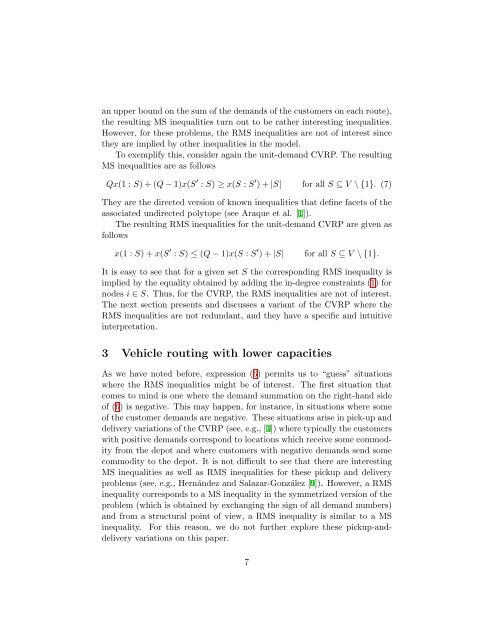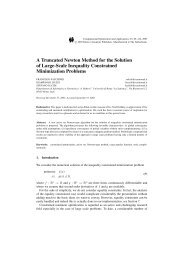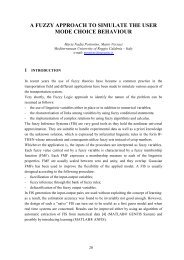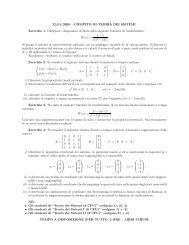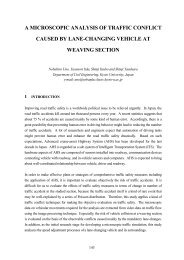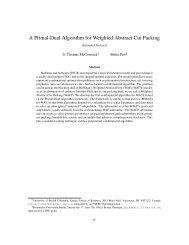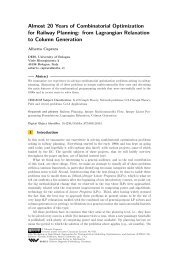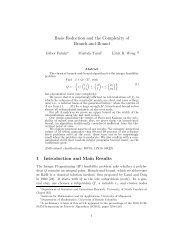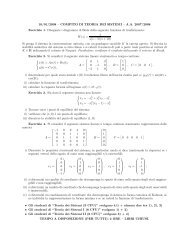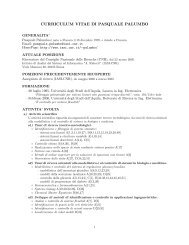Reverse Multistar Inequalities and Vehicle Routing ... - IASI-CNR
Reverse Multistar Inequalities and Vehicle Routing ... - IASI-CNR
Reverse Multistar Inequalities and Vehicle Routing ... - IASI-CNR
You also want an ePaper? Increase the reach of your titles
YUMPU automatically turns print PDFs into web optimized ePapers that Google loves.
an upper bound on the sum of the dem<strong>and</strong>s of the customers on each route),<br />
the resulting MS inequalities turn out to be rather interesting inequalities.<br />
However, for these problems, the RMS inequalities are not of interest since<br />
they are implied by other inequalities in the model.<br />
To exemplify this, consider again the unit-dem<strong>and</strong> CVRP. The resulting<br />
MS inequalities are as follows<br />
Qx(1 : S) + (Q − 1)x(S ′ : S) ≥ x(S : S ′ ) + |S| for all S ⊆ V \ {1}. (7)<br />
They are the directed version of known inequalities that define facets of the<br />
associated undirected polytope (see Araque et al. [1]).<br />
The resulting RMS inequalities for the unit-dem<strong>and</strong> CVRP are given as<br />
follows<br />
x(1 : S) + x(S ′ : S) ≤ (Q − 1)x(S : S ′ ) + |S| for all S ⊆ V \ {1}.<br />
It is easy to see that for a given set S the corresponding RMS inequality is<br />
implied by the equality obtained by adding the in-degree constraints (1) for<br />
nodes i ∈ S. Thus, for the CVRP, the RMS inequalities are not of interest.<br />
The next section presents <strong>and</strong> discusses a variant of the CVRP where the<br />
RMS inequalities are not redundant, <strong>and</strong> they have a specific <strong>and</strong> intuitive<br />
interpretation.<br />
3 <strong>Vehicle</strong> routing with lower capacities<br />
As we have noted before, expression (6) permits us to “guess” situations<br />
where the RMS inequalities might be of interest. The first situation that<br />
comes to mind is one where the dem<strong>and</strong> summation on the right-h<strong>and</strong> side<br />
of (6) is negative. This may happen, for instance, in situations where some<br />
of the customer dem<strong>and</strong>s are negative. These situations arise in pick-up <strong>and</strong><br />
delivery variations of the CVRP (see, e.g., [4]) where typically the customers<br />
with positive dem<strong>and</strong>s correspond to locations which receive some commodity<br />
from the depot <strong>and</strong> where customers with negative dem<strong>and</strong>s send some<br />
commodity to the depot. It is not difficult to see that there are interesting<br />
MS inequalities as well as RMS inequalities for these pickup <strong>and</strong> delivery<br />
problems (see, e.g., Hernández <strong>and</strong> Salazar-González [9]). However, a RMS<br />
inequality corresponds to a MS inequality in the symmetrized version of the<br />
problem (which is obtained by exchanging the sign of all dem<strong>and</strong> numbers)<br />
<strong>and</strong> from a structural point of view, a RMS inequality is similar to a MS<br />
inequality. For this reason, we do not further explore these pickup-<strong>and</strong>delivery<br />
variations on this paper.<br />
7


